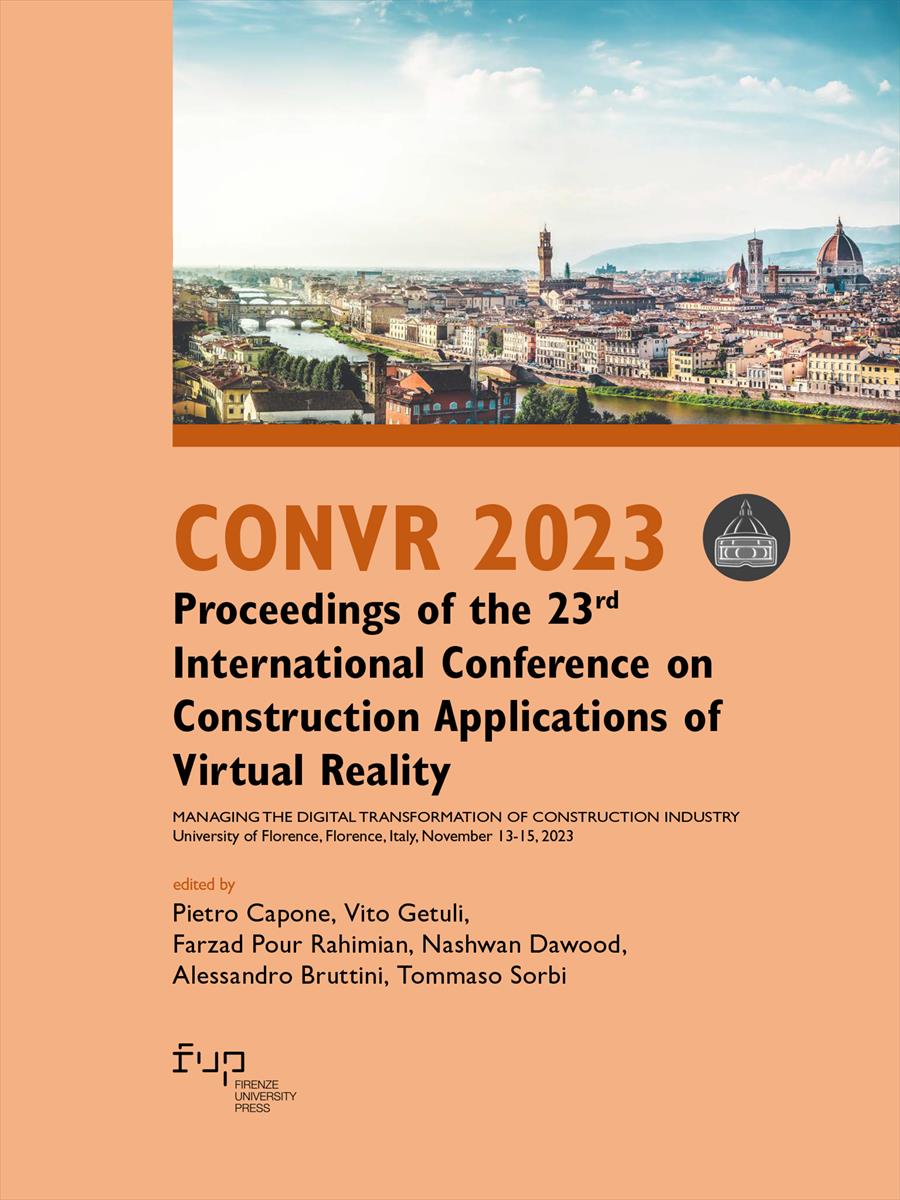- CONVR 2023 - Proceedings of the 23rd International Conference on Construction Applications of Virtual Reality
- Edited by Pietro Capone, Vito Getuli, Farzad Pour Rahimian, Nashwan Dawood, Alessandro Bruttini, Tommaso Sorbi
Integration Between Enterprise Resource Planning and Building Information Modelling
- Paola Federici
- Daniela Julea
- Sara Comai
- Kavita Raj
- Silvia Mastrolembo Ventura
- Giuseppe Rigamonti
- Giorgio Paolo Maria Vassena
- Angelo Luigi Camillo CIRIBINI
- © 2023 Author(s) |
- CC BY-NC 4.0
- DOI: 10.36253/979-12-215-0289-3.43
Enterprise resource planning (ERP) is an integrated business management system aimed at monitoring and maximizing resources and efficiency; on the other hand, Building Information Modelling (BIM) represents a broad series of approaches to design, based on the development of virtual models that cover the building’s whole lifecycle. The integration of ERP systems within the Architecture, Engineering and Construction industry, while promising, has yet to reach the same results that its use has achieved in other fields. Although BIM and ERP are traditionally systems employed in different disciplines, they both deal with data integration and customization, and are designed to reconcile varied and scattered information. A mutual incorporation could allow for a more comprehensive understanding of the project starting from the initial phases, while also granting a more streamlined construction process and a reduction in errors and complications later on. The aim of this paper is to identify the possible connections between the two systems examining a case study, starting from an analysis of the current state of the art regarding this implementation, and by evaluating both the existing limits and the future possibilities of this implementation, for both small and medium enterprises (SMEs) and the industry at large
- Keywords:
- Enterprise Resource Planning (ERP),
- Building Information Modelling (BIM),
- Small Medium Enterprises (SMEs),
- AEC,
- Construction,
- Data integration,
University of Brescia, Italy - ORCID: 0009-0007-6204-0330
University of Brescia, Italy
University of Brescia, Italy - ORCID: 0000-0001-6559-6624
University of Brescia, Italy
University of Brescia, Italy - ORCID: 0000-0001-9446-8824
Politecnico di Milano, Italy
University of Brescia, Italy
University of Brescia, Italy - ORCID: 0000-0001-8863-3440
- Al-Amin, M., Hossain, T., Islam, J., & Biwas, S. K. (2023). History, Features, Challenges, and Critical Success Factors of Enterprise Resource Planning (ERP) in The Era of Industry 4.0. European Scientific Journal, ESJ, 19(6), 31.
- Andresen, J., Baldwin, A., Betts, M., Carter, C., Hamilton, A., Stokes, E., & Thorpe, T. (2002). A framework for measuring IT innovation benefits. Journal of Information Technology in Construction (ITcon), 5(4), 57-72.
- Augenbroe, G. (2006). ERP for the home building industry. College of Architecture, Georgia Institute of Technology.
- Dudgikar, C. S., Kumthekar, M. B., & Khot, S. R. (2012). Development of ERP module for quality management in construction industry. International Journal of Electronics and Communications (IJEC), 1(1), 29-40.
- Gavali, A., & Halder, S. (2020). Identifying critical success factors of ERP in the construction industry. Asian Journal of Civil Engineering, 21, 311-329.
- Ghosh, S., Negahban, S., Kwak, Y. H., & Skibniewski, M. J. (2011, June). Impact of sustainability on integration and interoperability between BIM and ERP-A governance framework. In First International Technology Management Conference (pp. 187-193). IEEE.
- Helo, P., & Szekely, B. (2005). Logistics information systems: an analysis of software solutions for supply chain co‐ordination. Industrial Management & Data Systems, 105(1), 5-18.
- Holzer, D. (2014). Fostering the link from PLM to ERP via BIM: the AEC industry in transition. In Product Lifecycle Management for a Global Market: 11th IFIP WG 5.1 International Conference, PLM 2014, Yokohama, Japan, July 7-9, 2014, Revised Selected Papers 11 (pp. 75-82). Springer Berlin Heidelberg.
- Jacobs, F. R. (2007). Enterprise resource planning (ERP) - A brief history. Journal of operations management, 25(2), 357-363.
- Katuu, S. (2020). Enterprise resource planning: past, present, and future. New Review of Information Networking, 25(1), 37-46.
- Khan, M. A. (2022). Integrating BIM with ERP Systems Towards an Integrated Multi-user Interactive Database: Reverse-BIM Approach. In Recent Trends in Construction Technology and Management: Select Proceedings of ACTM 2021 (pp. 209-220). Singapore: Springer Nature Singapore.
- Kumar, K., & Van Hillegersberg, J. (2000). ERP experiences and evolution. Communications of the ACM, 43(4), 22-22.
- Lee, S., Arif, A., & Halpin, D. (2002, April). Simulation modeling by enterprise resource planning implementation in medium sized corporation. In First International Conference on Construction in the 21st Century (CITC-2002), Miami, FL (pp. 663-670).
- Ross, J. W. (1999). Surprising facts about implementing ERP. IT professional, 1(4), 65-68.
- Shi, J. J., & Halpin, D. W. (2003). Enterprise resource planning for construction business management. Journal of construction engineering and management, 129(2), 214-221.
- Wang, X., & Love, P. E. (2012, May). BIM+ AR: Onsite information sharing and communication via advanced visualization. In Proceedings of the 2012 IEEE 16th International Conference on Computer Supported Cooperative Work in Design (CSCWD) (pp. 850-855). IEEE.
- Yang, J. B., Wu, C. T., & Tsai, C. H. (2007). Selection of an ERP system for a construction firm in Taiwan: A case study. Automation in construction, 16(6), 787-796.
Chapter Information
Chapter Title
Integration Between Enterprise Resource Planning and Building Information Modelling
Authors
Paola Federici, Daniela Julea, Sara Comai, Kavita Raj, Silvia Mastrolembo Ventura, Giuseppe Rigamonti, Giorgio Paolo Maria Vassena, Angelo Luigi Camillo CIRIBINI
DOI
10.36253/979-12-215-0289-3.43
Peer Reviewed
Publication Year
2023
Copyright Information
© 2023 Author(s)
Content License
Metadata License
Bibliographic Information
Book Title
CONVR 2023 - Proceedings of the 23rd International Conference on Construction Applications of Virtual Reality
Book Subtitle
Managing the Digital Transformation of Construction Industry
Editors
Pietro Capone, Vito Getuli, Farzad Pour Rahimian, Nashwan Dawood, Alessandro Bruttini, Tommaso Sorbi
Peer Reviewed
Publication Year
2023
Copyright Information
© 2023 Author(s)
Content License
Metadata License
Publisher Name
Firenze University Press
DOI
10.36253/979-12-215-0289-3
eISBN (pdf)
979-12-215-0289-3
eISBN (xml)
979-12-215-0257-2
Series Title
Proceedings e report
Series ISSN
2704-601X
Series E-ISSN
2704-5846
